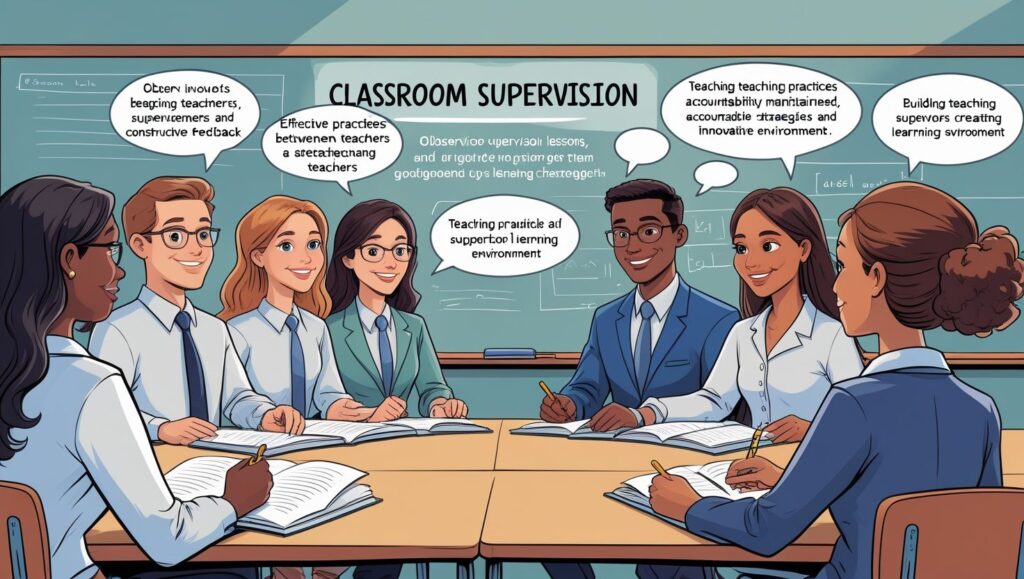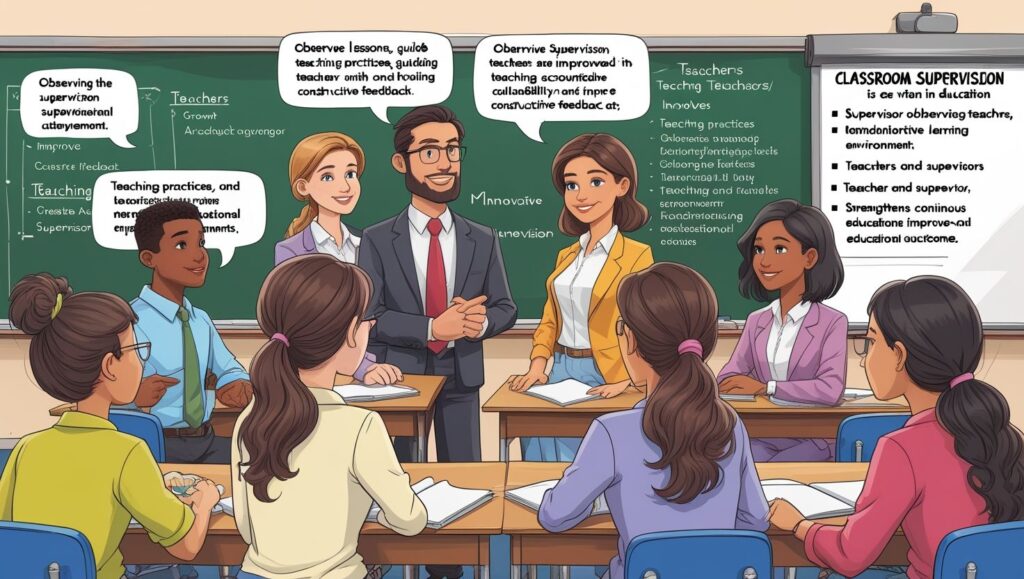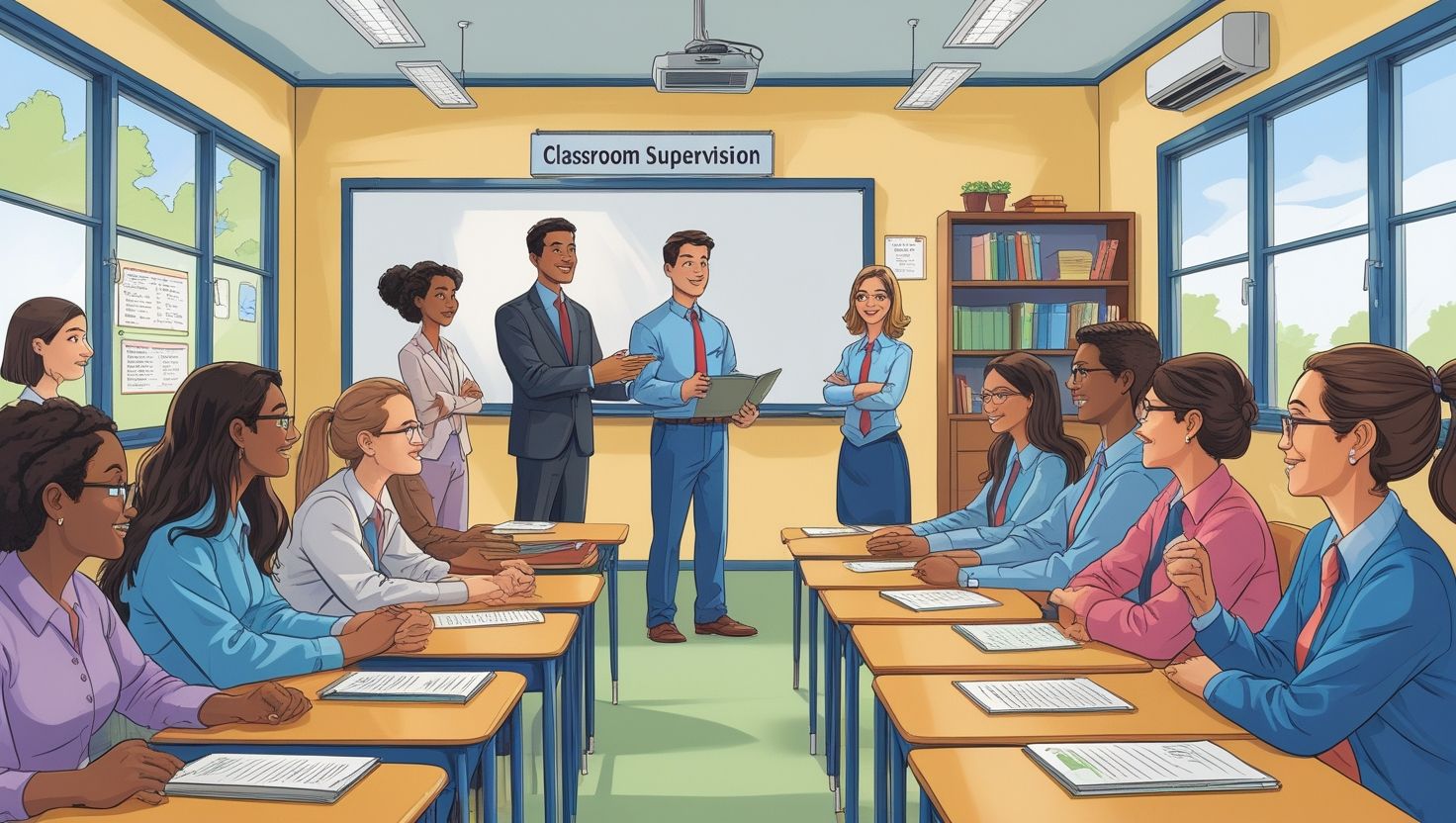Introduction
Classroom Supervision, Classroom supervision is an essential part of educational management. It focuses on monitoring, guiding, and supporting teaching and learning processes. In every school, effective supervision ensures that students achieve academic success and teachers maintain professional standards. Supervisors, usually principals or senior teachers, observe teaching practices, evaluate performance, and suggest improvements. Consequently, it bridges the gap between planning and actual classroom delivery. Moreover, supervision is not limited to criticism; it is a developmental process. It involves encouragement, mentoring, and constructive feedback. In fact, when done properly, it strengthens teachers’ confidence and motivates them toward professional growth.
Additionally, students also benefit directly from improved classroom management and instructional strategies. Thus, classroom supervision promotes a positive learning environment. Teachers gain direction, learners get better learning experiences, and schools maintain academic quality. Importantly, supervision must be continuous, systematic, and supportive. Only then can it fulfill its real purpose. Therefore, it is not about authority but about guidance and collaboration. Overall, classroom supervision acts as the backbone of educational quality and improvement. Without it, teaching may lack consistency, direction, and accountability.
Objectives of Classroom Supervision
The main objectives of classroom supervision revolve around improvement, accountability, and support. First, it ensures quality teaching. Teachers are guided to use effective teaching methods and manage classrooms better. Furthermore, supervision helps identify teachers’ strengths and weaknesses. By doing so, supervisors provide constructive feedback that enhances performance. Another objective is professional growth. Teachers, through supervision, receive mentoring that develops their instructional and management skills. Additionally, supervision ensures that educational standards and policies are followed consistently. This prevents irregularities and promotes fairness.
Moreover, supervision encourages innovation in teaching. Teachers often adopt new methods when supported and guided properly. Equally important, it maintains discipline in both teaching and learning. It assures that students are provided with the right environment for success. Supervision also establishes accountability. Teachers know their performance is monitored, which motivates them to work responsibly. Therefore, supervision is not only evaluative but also developmental. Its ultimate goal is student achievement. When teachers are effectively supervised, students benefit through improved learning outcomes. Thus, the objectives of classroom supervision focus on building strong teaching practices, motivating teachers, and improving student performance.

Methods of Classroom Supervision
Classroom supervision is conducted through different methods. Each method serves specific purposes and suits different situations. One common method is classroom observation. Supervisors directly observe teaching and learning activities. This allows them to identify areas of strength and weakness. Another method is feedback sessions. After observation, supervisors discuss performance with teachers. These sessions encourage reflection and self-improvement. Additionally, supervisors may use checklists or evaluation forms. Such tools make supervision systematic and objective. Peer supervision is another useful method. Teachers observe one another and exchange constructive feedback. This builds collaboration and mutual learning. Moreover, supervisors may conduct demonstration lessons.
These provide teachers with practical examples of effective teaching strategies. Workshops and training sessions also fall under supervision methods. They help teachers improve specific skills. Furthermore, supervision may include reviewing lesson plans and student assessments. This ensures alignment with curriculum standards. Importantly, supervisors should use multiple methods. Relying on only one method limits effectiveness. Therefore, combining observation, feedback, training, and collaboration ensures comprehensive supervision. As a result, supervision becomes supportive, developmental, and fair. Ultimately, effective methods encourage teachers to grow professionally while enhancing student learning outcomes.
Role of the Teacher in Supervision
Teachers play a central role in the process of supervision. They are not passive recipients but active participants. In fact, effective supervision depends largely on teacher cooperation. Teachers must be open to observation and feedback. When they accept suggestions positively, supervision becomes meaningful. Additionally, teachers should reflect on their practices. Self-assessment combined with supervisor feedback enhances improvement. Teachers also contribute by sharing challenges and seeking guidance. This openness creates a two-way communication channel. Moreover, teachers can suggest innovative methods during supervision. Their creativity often adds value to the process. Another important role of teachers is professional commitment. They must continuously strive to improve their teaching methods.
Furthermore, teachers should participate in workshops, training, and peer supervision activities. Such involvement demonstrates willingness to learn and grow. Teachers also support supervisors by maintaining accurate lesson plans and student records. This makes evaluation easier and more transparent. Importantly, teachers should view supervision as an opportunity, not a threat. When they cooperate, supervision becomes developmental rather than judgmental. Therefore, teachers’ role is proactive, reflective, and collaborative. Ultimately, teacher involvement ensures that supervision achieves its goal of quality education.
Role of the Supervisor
Supervisors, whether principals, administrators, or senior teachers, carry significant responsibility. Their role is not only to monitor but also to guide and support teachers. Firstly, supervisors must observe teaching practices fairly and systematically. They should identify strengths, point out weaknesses, and offer practical suggestions. Additionally, supervisors must provide constructive feedback. Criticism alone discourages teachers. Therefore, balanced feedback motivates teachers to improve. Another important role is mentoring. Supervisors act as role models, guiding teachers with experience and expertise. They also organize training sessions and workshops for skill development. Moreover, supervisors maintain accountability. They ensure that teaching standards and policies are followed consistently. Equally important, they promote innovation by encouraging teachers to experiment with new methods. Supervisors should also resolve conflicts, if any, between teachers and students.
Their role involves creating a healthy, disciplined learning environment. Furthermore, supervisors must practice fairness and avoid bias. Transparency in supervision builds trust and cooperation. Importantly, supervisors must view themselves as partners, not controllers. Their role is collaborative, developmental, and supportive. Ultimately, supervisors bridge the gap between school goals and classroom practices. Through effective supervision, they ensure academic excellence and professional growth.
Challenges in Classroom Supervision
Classroom supervision faces several challenges that affect its effectiveness. One major challenge is teacher resistance. Some teachers perceive supervision as judgmental and threatening. Consequently, they resist feedback and suggestions. Another challenge is lack of time. Supervisors often manage multiple responsibilities, leaving limited time for classroom visits. Additionally, inadequate training of supervisors is a problem. Without proper skills, supervision becomes ineffective. Resource constraints also hinder supervision. Limited teaching materials, overcrowded classrooms, and poor infrastructure reduce its impact. Moreover, personal biases sometimes influence supervisors.
Favoritism or unfair treatment damages trust between teachers and supervisors. Another challenge is communication gaps. If feedback is not clear or supportive, teachers may misunderstand it. Furthermore, cultural or institutional barriers can affect supervision. Some schools lack a supportive environment for open dialogue. Also, rapid changes in curriculum demand constant adaptation, which can overwhelm both teachers and supervisors. Importantly, supervision may also fail if it focuses only on faults rather than development. These challenges highlight the need for systematic planning. Overcoming them requires proper training, fairness, and collaboration. When addressed effectively, supervision becomes supportive, motivating, and results-driven, ultimately benefiting students’ learning outcomes.

Strategies for Effective Classroom Supervision
To overcome challenges, effective strategies must be applied. First, supervisors should adopt a supportive approach. Encouragement and constructive feedback motivate teachers. Additionally, supervision should be continuous, not occasional. Regular visits help monitor progress and provide timely guidance. Another strategy is training supervisors. Skilled supervisors understand how to observe, evaluate, and guide effectively. Moreover, using multiple methods enhances supervision. Combining observation, peer review, workshops, and feedback sessions makes supervision more comprehensive. Importantly, communication must be open and transparent. Teachers should feel comfortable sharing challenges and suggestions.
Furthermore, supervisors must avoid bias and favoritism. Fairness builds trust and cooperation. Another strategy is integrating technology. Video recordings of lessons, online feedback systems, and digital tools improve efficiency. Moreover, collaboration between teachers and supervisors should be encouraged. Joint problem-solving enhances professional growth. Supervisors must also focus on positive aspects of teaching, not just weaknesses. Recognizing achievements boosts motivation. Additionally, aligning supervision with school goals ensures consistency. Ultimately, supervision should aim for professional development, not punishment. When strategies are applied effectively, supervision becomes a partnership. As a result, both teachers and students benefit from improved teaching and learning experiences.
Conclusion
Classroom supervision is the backbone of quality education. It ensures that teaching is effective, consistent, and aligned with educational goals. Moreover, it supports teachers by identifying strengths, addressing weaknesses, and offering developmental guidance. Both teachers and supervisors play crucial roles in the process. Teachers must cooperate, reflect, and embrace suggestions. Supervisors, on the other hand, must be fair, supportive, and skilled. However, challenges such as resistance, lack of time, and inadequate training often hinder the process.
These challenges require systematic strategies. By promoting openness, fairness, and continuous improvement, supervision becomes more effective. Importantly, it should never be seen as a form of control but as a tool for development. Through classroom supervision, teaching standards rise, professional growth is encouraged, and student performance improves. Therefore, schools must prioritize supervision as an integral part of educational management. With proper implementation, supervision strengthens learning environments and creates better academic outcomes. Ultimately, classroom supervision shapes the quality of education and contributes significantly to student success. Without it, schools risk inconsistency, weak teaching practices, and lower learning achievements.

3byycn
Such a simple yet powerful message. Thanks for this.
Keep writing! Your content is always so helpful.
hdd2bv
jaxx5w
ztq3iz
Good post however , I was wondering if you
could write a litte more on this topic? I’d be very grateful
if you could elaborate a little bit more.
Cheers! https://Glassi-greyhounds.mystrikingly.com/